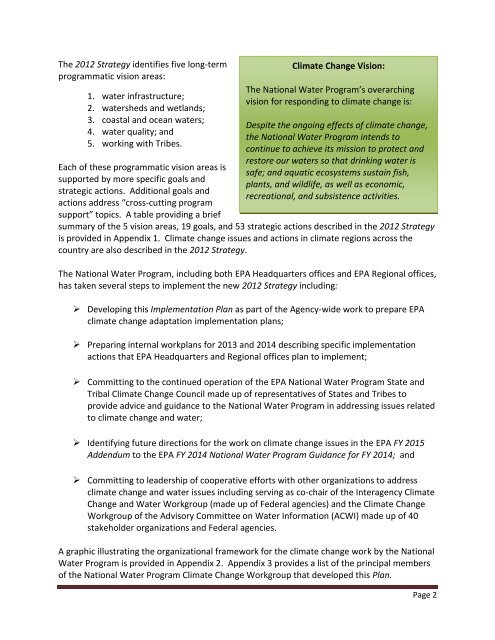OW-climate-change-adaptation-plan
OW-climate-change-adaptation-plan
OW-climate-change-adaptation-plan
You also want an ePaper? Increase the reach of your titles
YUMPU automatically turns print PDFs into web optimized ePapers that Google loves.
The 2012 Strategy identifies five long-term<br />
programmatic vision areas:<br />
1. water infrastructure;<br />
2. watersheds and wetlands;<br />
3. coastal and ocean waters;<br />
4. water quality; and<br />
5. working with Tribes.<br />
Each of these programmatic vision areas is<br />
supported by more specific goals and<br />
strategic actions. Additional goals and<br />
actions address “cross-cutting program<br />
support” topics. A table providing a brief<br />
Climate Change Vision:<br />
The National Water Program’s overarching<br />
vision for responding to <strong>climate</strong> <strong>change</strong> is:<br />
Despite the ongoing effects of <strong>climate</strong> <strong>change</strong>,<br />
the National Water Program intends to<br />
continue to achieve its mission to protect and<br />
restore our waters so that drinking water is<br />
safe; and aquatic ecosystems sustain fish,<br />
<strong>plan</strong>ts, and wildlife, as well as economic,<br />
recreational, and subsistence activities.<br />
summary of the 5 vision areas, 19 goals, and 53 strategic actions described in the 2012 Strategy<br />
is provided in Appendix 1. Climate <strong>change</strong> issues and actions in <strong>climate</strong> regions across the<br />
country are also described in the 2012 Strategy.<br />
The National Water Program, including both EPA Headquarters offices and EPA Regional offices,<br />
has taken several steps to implement the new 2012 Strategy including:<br />
‣ Developing this Implementation Plan as part of the Agency-wide work to prepare EPA<br />
<strong>climate</strong> <strong>change</strong> <strong>adaptation</strong> implementation <strong>plan</strong>s;<br />
‣ Preparing internal work<strong>plan</strong>s for 2013 and 2014 describing specific implementation<br />
actions that EPA Headquarters and Regional offices <strong>plan</strong> to implement;<br />
‣ Committing to the continued operation of the EPA National Water Program State and<br />
Tribal Climate Change Council made up of representatives of States and Tribes to<br />
provide advice and guidance to the National Water Program in addressing issues related<br />
to <strong>climate</strong> <strong>change</strong> and water;<br />
‣ Identifying future directions for the work on <strong>climate</strong> <strong>change</strong> issues in the EPA FY 2015<br />
Addendum to the EPA FY 2014 National Water Program Guidance for FY 2014; and<br />
‣ Committing to leadership of cooperative efforts with other organizations to address<br />
<strong>climate</strong> <strong>change</strong> and water issues including serving as co-chair of the Interagency Climate<br />
Change and Water Workgroup (made up of Federal agencies) and the Climate Change<br />
Workgroup of the Advisory Committee on Water Information (ACWI) made up of 40<br />
stakeholder organizations and Federal agencies.<br />
A graphic illustrating the organizational framework for the <strong>climate</strong> <strong>change</strong> work by the National<br />
Water Program is provided in Appendix 2. Appendix 3 provides a list of the principal members<br />
of the National Water Program Climate Change Workgroup that developed this Plan.<br />
Page 2


